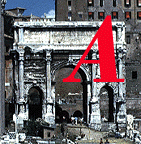
Commencement and Termination of the Scroll in the Cornice of the Clopton Chauntry, Long Belford Church, Suffolk. Plate 37, Gothic Ornament Drawn from Existing Authorities (1848) by James Kellaway Colling (1816-1905). 32.4 x 25.7 cm. This item was catalogue no. 45 in Beckwith, Victorian Bibliomania (1987) [Click on image to enlarge it.]
Commentary by Alice H. R. H. Beckwith

practicing architect and historian, James K. Colling gathered the information for Gothic Ornaments between 1836 and 1840 when he was in Norfolk (Jervis, Design and Designers 122). Colling wrote his book and illustrated it with chromolithographs to show his architectural colleagues how brightly painted English Gothic buildings were. Like John Ruskin, he despised whitewash, proclaiming in Chapter II of his second volume: “That love of white wash, to which the Church Wardens of the last century were so pertinaciously addicted, was a puritanical notion, which was, probably, handed down to them from the time of the Reformation; and the sooner it is altogether got rid of along with the white ceilings of our dwelling houses, the better.” Colling also shared Ruskin's sensitivity to surface finish and twice quoted statements from Ruskin's Seven Lamps of Architecture (complete text on this site) in Gothic Ornaments.
The red, green, gold, and black cornice from Clopton Chauntry illustrated here gives some idea of what Colling had in mind when he disparaged white walls. All around the room just below the junction of the ceiling and the wall runs a scroll decorated with vines, leaves, flowers and gothic script. Augustus W. N. Pugin (see cats. 41-43) was attracted to the same illuminated chapel and illustrated it as well. Colling, Ruskin and Pugin shared an interest in architectural ornament as it related to manuscript arts, and Colling designed printed illuminated title pages for Gothic Ornaments. However, at this juncture Colling's likeness to Ruskin and Pugin ends, because he used shading and achieved the illusion of three-dimensional form in his illuminated works for both buildings and books. Beneath the vines and leaves of the Clopton Chauntry scroll, illusionistic black shadows suggest sculptural relief. Pugin and Ruskin rejected such light effects as a violation of the flat surface upon which architectural decorators and book illuminators worked.
Colling presented a threat to Pugin's and Ruskin's interpretations of Gothic arts and attitudes, since he claimed his drawings were copied directly from existing buildings. The sensuous three-dimensional quality of Colling's Clopton Chauntry scroll is found elsewhere in nineteenth-century illuminated books, wallpapers, and fabric designs, but not in the discussions by Pugin, Ruskin, Owen Jones, or William Morris of "approved" works. A force to be reckoned with, Colling published again in 1852, 1865, 1874, and 1880. He was a founding member of both the Association of Architectural Draughtsmen and the Architectural Association. The presence of his Gothic Ornaments in the library of the nineteenth-century Boston architect John Pickering Putnam (see cat. 44) speaks of Colling's international influence. Nonetheless, he is almost unknown today, while the reputations of Pugin, Ruskin, Jones, and Morris are still growing in importance.
Other plates from Gothic Ornament Drawn from Existing Authorities
- Title-page
- Painted oak panel from East Harling Church, Suffolk
- Floor tiles from Winchester Cathedral
You may use this image without prior permission for any scholarly or educational purpose as long as you (1) credit the Internet Archive and University of Maryland and (2) link your document to this URL in a web document or cite the Victorian Web in a print one.]
References
Beckwith, Alice H. R. H. Victorian Bibliomania: The Illuminated Book in Nineteenth-Century Britain. Exhibition catalogue. Providence. Rhode Island: Museum of Art, Rhode Island School of Design, 1987.
Colling, James Kellaway. Gothic Ornament Drawn from Existing Authorities. London: J. Jobbins. first volume published in 1848, second volume 1850. Printer: J. Jobbins. Illustrator: James K. Colling. Internet Archive version of a copy in the library of the University of Toronto. Web. 21 December 2013. [The copy of this book in the 1987 exhibition the copy came from an anonymous lender.]
Jervis, Simon. The Penguin Dictionary of Design and Designers. New York: Penguin, 1984.
Last modified 18 December 2013